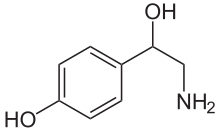Octopamine (neurotransmitter)
 |
|
| Clinical data | |
|---|---|
| Synonyms | OCT, Norsympathol, Norsynephrine, para-Octopamine, beta-Hydroxytyramine, para-hydroxy-phenyl-ethanolamine |
| Physiological data | |
| Source tissues | invertebrate nervous systems; trace amine in vertebrates |
| Target tissues | system-wide in invertebrates |
| Receptors |
TAAR1 (mammals) OctαR, OctβR, TyrR (invertebrates) |
| Precursor | tyramine |
| Biosynthesis | tyramine β-hydroxylase; dopamine β-hydroxylase |
| Metabolism | N-acetyltransferases; phenylethanolamine N-methyltransferase |
| Identifiers | |
|
|
| CAS Number | |
| PubChem CID | |
| IUPHAR/BPS | |
| ChemSpider | |
| KEGG | |
Octopamine is an organic chemical closely related to norepinephrine, and synthesized biologically by a homologous pathway. Its name derives from the fact that it was first identified in the salivary glands of the octopus.
In many types of invertebrates octopamine is an important neurotransmitter and hormone. In protostomes—arthropods, molluscs, and several types of worms—it substitutes for norephinephrine and performs functions apparently similar to those of norepinephrine in mammals, functions that have been described as mobilizing the body and nervous system for action.
Octopamine exerts its effects by binding to and activating receptors located on the surface of cells. These receptors have mainly been studied in insects, where they can be divided into three types: alpha-adrenergic-like (OctαR), which are structurally and functionally similar to noradrenergic alpha-1 receptors in mammals; beta-adrenergic-like (OctβR), which are structurally and functionally similar to noradrenergic beta receptors in mammals; and mixed octopamine/tyramine receptors (TyrR), which are structurally and functionally similar to noradrenergic alpha-2 receptors in mammals. Receptors in the TyrR class, however, are generally more strongly activated by tyramine than by octopamine.
In vertebrates no octopamine-specific receptors have been identified. Octopamine binds weakly to receptors for norepinephrine and epinephrine, but it is not clear whether this has any functional significance. It binds more strongly to trace amine-associated receptors (TAARs), especially TAAR1.
Octopamine was first discovered by Italian scientist Vittorio Erspamer in 1948 in the salivary glands of the octopus and has since been found to act as a neurotransmitter, neurohormone and neuromodulator in invertebrates. Although Erspamer discovered its natural occurrence and named it, octopamine had actually existed for many years as a pharmaceutical product. It is widely used in energy-demanding behaviors by all insects, crustaceans (crabs, lobsters, crayfish), and spiders. Such behaviors include flying, egg-laying, and jumping.
...
Wikipedia
